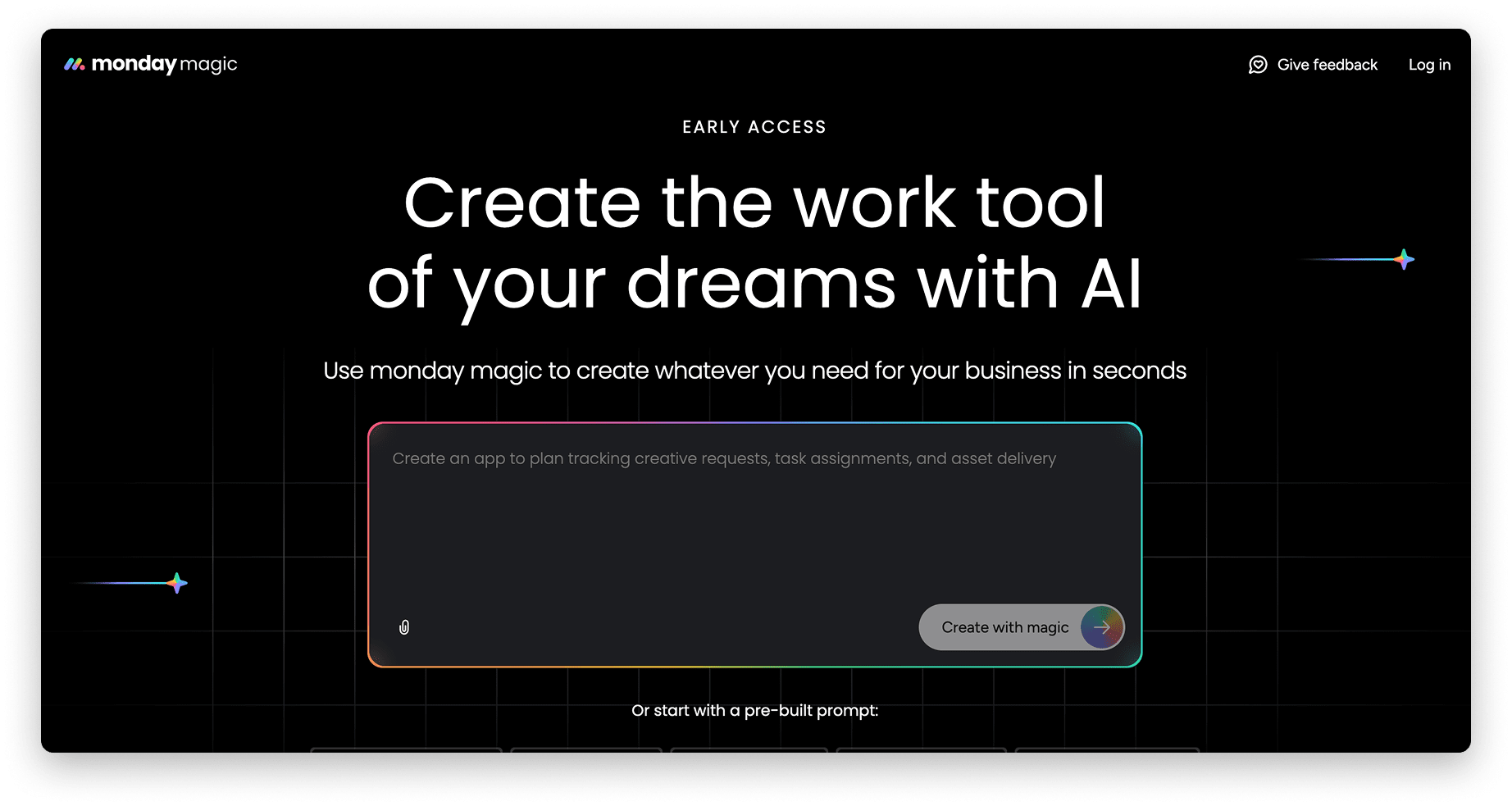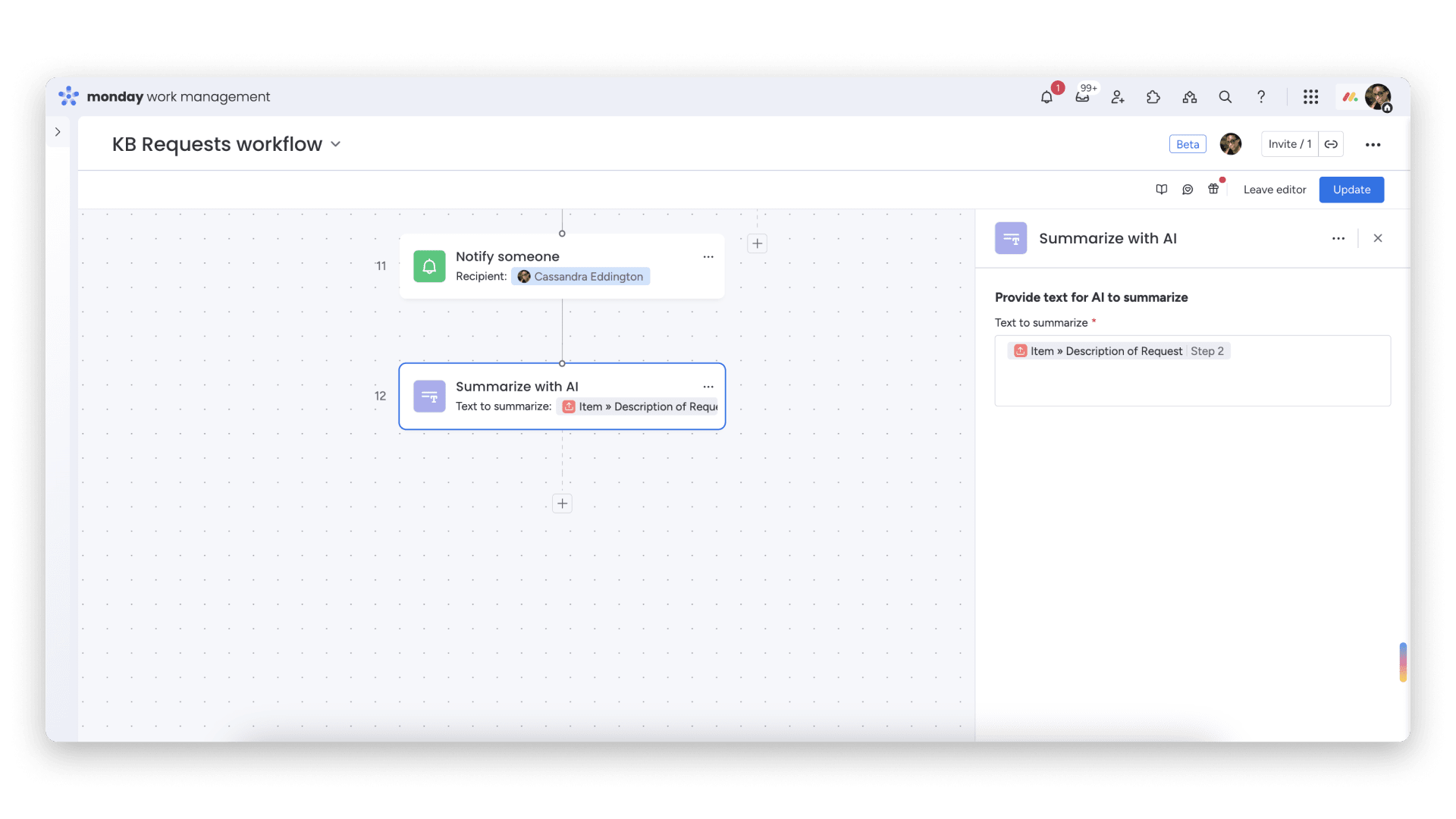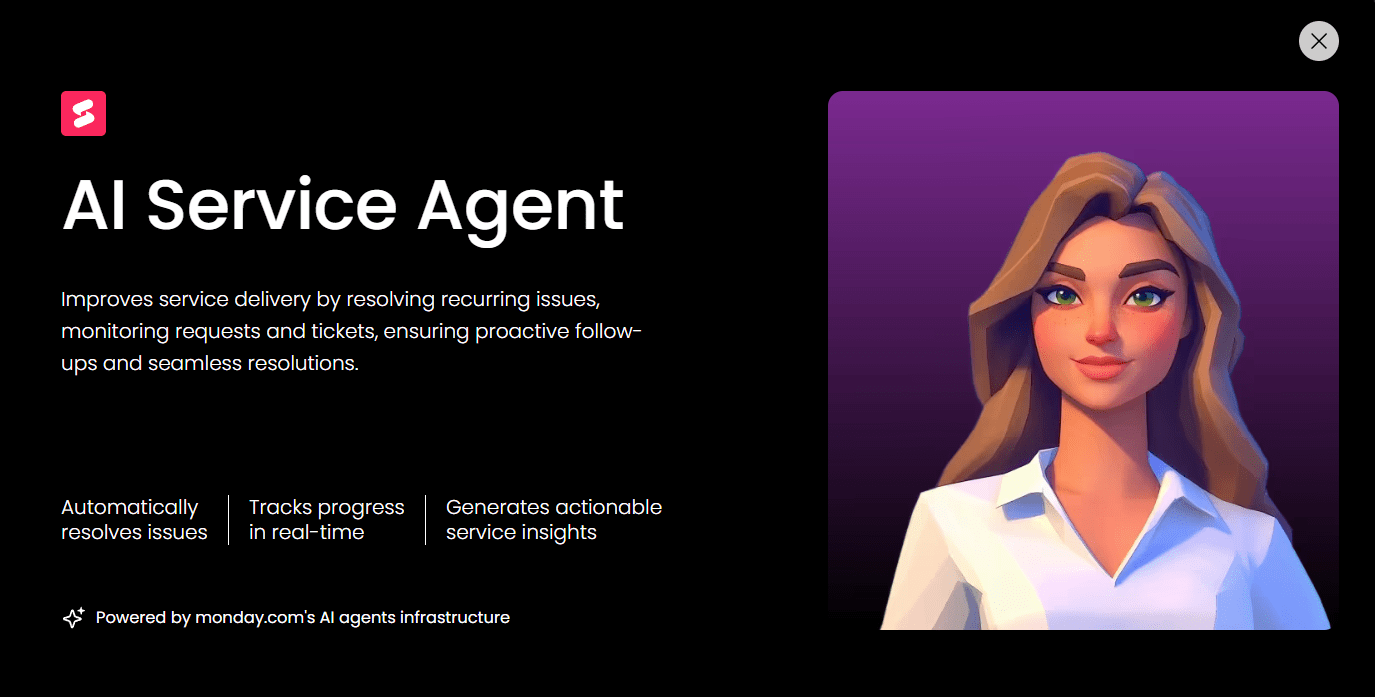Best supplier. Best price. Least amount of hassle. This trifecta is the holy grail for procurement teams, but it’s not easy to achieve when demands are high and resources are stretched thin.
That’s where AI in procurement is starting to prove its worth as a practical tool that helps teams see clearer and spend wiser. In this guide, we’ll unpack how AI is already a mainstay of procurement, where it’s delivering real results, and how tools like monday service make it easier to get started.
Try monday serviceKey takeaways
- AI is already making an impact in procurement, as a tool teams use every day to make better deals.
- From drafting supplier emails to classifying spend data, AI shines when it removes friction from the flow of work.
- Getting started doesn’t require a transformation program. Small steps, like improving data hygiene or automating routine approvals, are already providing quick wins.
- Challenges like data quality, change resistance, and legacy tools are real, but they’re not deal-breakers. Most can be addressed with stringent planning and stakeholder buy-in.
- monday service brings every aspect of procurement management software together and lets AI work its magic. With no-code features and flexible workflows, our platform is built for real-world procurement teams, with no tech background required.
What is AI in procurement?
AI in procurement involves using artificial intelligence to make buying smarter, faster, and more efficient. Whether it’s sourcing a vendor, managing contracts, or tracking spend, AI helps teams cut down on manual work and make better decisions, backed by real-time data and intelligent automations.
It’s an approach that sounds almost futuristic, but the reality is that 62% of companies are already making use of generative AI tools in procurement. From auto-classifying supplier requests to drafting contracts and detecting pricing anomalies, AI has transformed how procurement teams operate and what they’re capable of.
What types of AI support procurement?
Procurement teams can tap into several types of AI technologies, including:
- Artificial intelligence: An umbrella term for smart technologies that simulate human thinking, such as decision-making, learning and automation.
- Machine learning: A subset of AI that identifies patterns in procurement data to make predictions, flag anomalies, and improve over time.
- Robotic process automation: Procurement software that mimics human actions to handle repetitive tasks like data entry, invoice matching, or PO creation.
- Natural language processing: Technology that understands and generates human language, which is useful for chatbots, email parsing, contract analysis, and supplier communications.
- Optical character recognition: Used to extract text from scanned documents, PDFs, and images, making legacy or paper-based supplier data usable in digital workflows.
What are the benefits of using AI in procurement?
The conversation around AI in procurement has moved past “if” and “when.” Now it’s about where it’s actually helping. Here’s the value you can expect from you slide AI into your procurement workflows.
Intelligent decision-making
AI helps procurement teams make the right calls at lightning speed. Say you’re evaluating two suppliers. Instead of manually comparing delivery performance and pricing history, AI can pull that data together, recognize any key patterns, and even highlight potential risks. It doesn’t make the final decision for you (unless you want it to) but it gives you a really strong base to work from.
Greater efficiency and cost savings
Procurement teams are under serious pressure, with workloads projected to rise by 10% in 2025, but budgets only growing 1%. AI helps close you bridge the 9% gap; early adopters of AI-driven procurement tools have already seen up to 10% improvements in productivity, quality, and cost savings, but the true upside is just beginning. As Christopher Sawchuk of The Hackett Group puts it,
The real opportunity lies in scaling AI-driven transformation across sourcing, contract management, and supplier collaboration.
Better negotiations
It’s easier to stand your ground in a negotiation when you’re armed with real-time pricing insights. AI can flag when a supplier’s quote drifts from current market conditions, giving you a clear reason to push back or walk away.
Reduced risk
When problems loom, AI gives procurement management teams valuable information and more time to take action. Whether it’s a missed delivery, a contract about to expire, or unusual pricing from a supplier, AI can flag what’s off and bring it to your immediate attention.
Enhanced supplier management
Procurement teams face a common question: how well are their suppliers performing? And with AI, they don’t have to rely on gut instinct to find out. From tracking delivery accuracy to analyzing sentiment in supplier communication, AI clearly signals what’s working (and what’s not.) The technology makes it easier to hold vendors accountable and build stronger partnerships over time.
5 examples of how to use generative AI in procurement
As generative AI tools move from experiment to implementation, procurement teams use them in specific, highly practical ways. In fact, 42% of organizations plan to invest in new GenAI capabilities, while another 33% are upgrading what they already have.
Here are 5 ways procurement teams are putting generative AI to work:
1. Spend classification
AI can analyze line-level transaction data and assign spend categories automatically, even when descriptions are inconsistent or vague. That means less time cleaning spreadsheets and more time spotting savings opportunities.
2. Real-time market data summaries
Rather than manually compiling news or pricing updates from suppliers and markets, GenAI can generate briefings from thousands of sources to give procurement teams relevant context in the moment. These sources include:
- Competitor activity
- Geopolitical shifts
- Raw material costs
3. Anomaly detection
Generative AI models can be trained to recognize outliers in pricing, delivery schedules, or supplier behavior. Whether it’s a duplicate invoice or a vendor suddenly missing deadlines, AI will spot the issue before it becomes a real problem.

4. Contract drafting or redlining
GenAI can draft initial versions of procurement contracts and compare them with your previous contract templates and company policies. From here, it’ll suggest alternate language or flag risky clauses. This use case reduces legal review time and lowers the risk of inconsistencies.
5. Supplier outreach email generation
Whether you’re requesting quotes, following up on documentation, or communicating award decisions, GenAI can draft supplier-facing emails that are tailored to the precise context you need, saving teams from writing the same messages over and over.
How monday service powers AI-driven procurement
Procurement teams are under growing pressure to achieve more with less. But staying responsive while managing complexity across tools, teams, and time zones is no easy feat. That’s where the right service technology makes all the difference.
monday service uses AI-powered operations to bring structure and intelligence to your procurement workflows. Here’s what you can expect.
Gain real-time procurement insights with AI-powered dashboards
Procurement teams need full visibility into what’s happening across sourcing, supplier performance, and internal demand. That’s where monday service excels, equipping teams with real-time dashboards that bring together key metrics like ticket volume, SLA status, procurement cycle times, and vendor-related issues, all in one place.
With AI-enhanced features like board previews, users can instantly grasp the status of procurement workflows without opening every board. Whether tracking contract bottlenecks, high-volume request categories, or vendor-specific escalations, monday service provides a dynamic, centralized view that keeps procurement aligned with business goals, enabling them to adapt quickly when things change.
Create powerful ready-to-use procurement workflows
Building procurement processes from scratch can be slow and resource-heavy. monday service eliminates that friction with ready-to-use templates designed for sourcing requests, vendor management, and contract approvals. These workflows are no-code and customizable, meaning procurement teams can start managing requests and approvals in minutes, not weeks.
monday magic takes this a step further by intelligently suggesting automation recipes and board configurations based on your existing processes. For example, it can recommend steps for auto-approvals or propose automation steps that remove manual handoffs. Instead of guessing how to optimize a process, teams can rely on AI-driven guidance to launch workflows that are both fast and future-ready.
The result? Procurement teams spend less time configuring tools and more time delivering value for the business.

Auto-generate procurement tickets from any channel
Procurement requests don’t always come from a single source — they’re buried in emails, direct messages, forms, or even informal conversations. monday service supports teams by automatically converting incoming messages into structured procurement tickets. .
Through integrations with tools like Outlook, Gmail, and Slack, any request — whether it’s a software purchase, vendor issue, or sourcing escalation — instantly creates a trackable ticket on your monday service board. From there, AI Blocks like Categorize and Assign Labels kick in to classify the request by urgency, type, or department, and route it to the right owner or workflow.
Summarize procurement communications in seconds
Procurement teams deal with a flood of communications, such as long vendor emails and complex contract PDFs or even multi-thread internal messages about changing requirements. Parsing all of this manually eats up valuable time and increases the risk of missed details or delayed responses.
With AI Blocks like Summarize and Extract Info, monday service helps teams cut through the noise. Vendor updates, delivery notices, pricing changes, or contract revisions are automatically distilled into key points, deadlines, and next steps, right within the workflow.
Whether preparing for a supplier call or escalating an issue for legal review, AI-powered summarization makes sure everyone’s working from the same clear, concise understanding.

Delegate procurement tasks to an always-on AI workforce
As procurement volumes grow, manual processes can’t keep pace. Teams are stretched thin as they monitor supplier performance and track recurring issues, especially when faced with tight turnaround times and lean staffing. monday service solves this with its digital workforce: AI-driven assistants designed to handle real work around the clock.

These specialized digital workers workers continuously learn from human input and adapt over time. For example, the AI Service Agent can monitor procurement tickets and flag patterns, like repeated delivery delays or pricing discrepancies, then generate weekly summary reports for decision-makers. Meanwhile, the Research Assistant can enrich vendor profiles with up-to-date company data or competitive insights, saving teams hours of research.
Unlike static automation, these AI-powered agents are proactive. They dig up intel and help procurement teams focus on strategic work, without needing to be prompted. It’s like adding a procurement analyst, a risk monitor, and a project tracker to your team, with zero additional headcount.
Try monday serviceHow to plan for common AI in procurement challenges
AI has clear advantages, but it’s rarely something you just plug in and profit from. Getting real value means understanding the roadblocks that could slow you down. The good news? Most of these challenges are predictable, which means they can be planned for and overcome. Here are a few to keep on your radar as you scale your AI efforts.
Data quality and cleanliness
AI systems rely on clean, complete, and well-structured data — something many procurement teams are still working toward. Fragmented supplier records, inconsistent naming conventions, and missing metadata all undermine AI performance.
It’s a known concern: 43% of procurement professionals say they’re worried about making decisions based on inaccurate or incomplete AI-generated data.
That’s why many teams are starting their AI journey by conducting some foundational work, such as tightening up procurement data standards and improving visibility across systems.
Change resistance from teams
Even with clear benefits, AI can send some of your team members into a spin at the idea of learning a new tool, especially one they may feel threatened by.
57% of procurement professionals say resistance to change is one of the biggest barriers to GenAI adoption, and 39% worry that AI could mistakenly agree to unfavorable deals.
To move forward with confidence, teams are thinking carefully about how they introduce AI, with clarity on when it’s assisting and when humans stay firmly in charge.
Integration with existing systems
Procurement tools are rarely greenfield. Teams often work across multiple platforms, from ERPs to ticketing systems, which makes integrating AI a logistical challenge.
47% of organizations have started embedding AI into their existing tools. But for others, legacy complexity continues to slow adoption. That’s why we’re seeing more teams evaluate AI as something that needs to be interoperable and easy to layer into what’s already working.
Ethical and compliance concerns
The promise of speed and automation has to be balanced with control and accountability, especially in procurement, where decisions affect finances, suppliers, and contracts.
More than half (55%) of professionals say governance issues are already stalling AI momentum. In response, organizations are starting to define AI guardrails early, not just for what the tools can do, but what they should do, and where human review stays essential.
How to start using AI in procurement
You don’t need to be a tech company to take advantage of AI. The best procurement teams aren’t launching massive transformation programs; they’re identifying quick wins and building confidence as they scale. Here’s what that path typically looks like.
1. Assess your current procurement workflows
Where do bottlenecks happen most often? What’s taking up too much time? Start by mapping out your existing processes to find the areas most ripe for AI support, like manual approvals, supplier vetting, or repetitive communication.
2. Audit your data
Before rolling out tools, look closely at the quality and consistency of your supplier, contract, and spend data. Are there duplicates? Gaps? Siloes? Addressing those issues early will pay off later.
3. Involve key stakeholders
IT, legal, finance, and end users all have skin in the game. Bring them into the conversation early, both for buy-in and to check that your AI initiatives align with broader goals around risk, compliance, and performance.
4. Set up your data governance policies
AI tools need boundaries. Only 15% of companies currently have generative AI governance policies in place, while another 19% are in the process of developing them. This is your chance to define how data is used and how decisions are reviewed.
5. Identify quick-win AI use cases
Start small and strategic. Look for use cases that don’t require full system overhauls, like using GenAI to draft supplier emails or summarize contract revisions. These early successes build trust and momentum. Sid Kalia, Vice President of WNS Procurement asserts,
True value doesn’t come from pushing the “AI” label. It comes when AI operates quietly under the hood — shortening sourcing cycles, streamlining supplier onboarding, spotting risk patterns early, improving decisions at scale.
6. Choose the right tools
Whether using embedded AI inside existing systems or layering new capabilities on top, focus on tools that are flexible and built for procurement realities. Bonus points if they let you experiment without deep IT dependency.
7. Train teams and feedback loops
Give your team the context, training, and reassurance they need to work with AI confidently. Make it clear where AI is assisting, not replacing. And don’t forget the feedback loop — human input helps AI systems improve over time.
8. Measure and optimize continuously
As AI becomes part of your daily operations, define the metrics that matter: turnaround time, error rates, supplier response time, or cost savings. Monitor them regularly and use what you learn to keep improving.
Turn AI potential into procurement performance with monday service
AI is a practical tool for teams that want to derive more value from every supplier relationship. But success comes from knowing where AI fits and having the right data and systems in place to support it.
That’s where monday service makes the difference. It’s built for real-world procurement teams, whether you’re leading sourcing for a global enterprise or managing vendors in a lean ops team.
And because it’s fully no-code, anyone can configure it, automate tasks, or scale processes across departments, all without relying on developers or IT. That means less friction, more action, and a quicker path to impact. Get a free trial of monday service today.
Try monday serviceFAQs about AI in procurement
What is the best AI for procurement?
The best AI for procurement depends on your team's goals, existing tools, and level of digital maturity. Many organizations are seeing strong results with embedded AI in platforms like monday service, which combine automation, machine learning, and predictive insights in one place. Look for AI that can support your full procurement lifecycle, from spend analysis to supplier management, and integrates easily with your current systems.
Will procurement be replaced by AI?
No, AI will not replace procurement, but it will reshape it. AI is designed to assist, not replace procurement professionals by automating repetitive tasks and speeding up intelligent decision-making. The role of the procurement team is evolving to become more strategic, with AI handling the busywork so humans can focus on value creation, relationship building, and risk management.
How do you use AI for sourcing?
Procurement teams can use AI for sourcing by automating supplier identification, scoring vendor proposals, and predicting supplier performance based on historical data. AI tools can also analyze global market trends and pricing benchmarks to support better sourcing decisions. For example, generative AI can draft RFPs or summarize supplier bids, saving significant time and improving consistency.
How do you apply AI to the supply chain?
Procurement professionals can apply AI to the supply chain by:
- Forecasting demand
- Optimizing inventory levels
- Tracking shipments in real time
- Detecting potential disruptions
When integrated with supply chain platforms, AI creates a more agile and resilient end-to-end operation.
How do you use AI to source leads?
AI can source procurement leads by analyzing external data, such as supplier directories, product catalogs, and industry databases, to identify vendors that match specific criteria. As a bonus, machine learning models can also predict which suppliers are most likely to deliver on quality, price, and timeline, based on past performance and market data. Some platforms even use natural language processing to extract insights from sources like supplier websites, news, and reviews.
 Get started
Get started 

